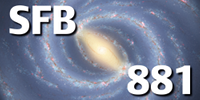Subproject A10: Thermonuclear supernovae as sources of iron group elements in the Milky Way
Friedrich Röpke (HITS/ITA)
Precision data on abundances measured from stars in the Milky Way call for an adequate theoretical modeling of its chemodynamical evolution. This approach is one of the most promising to understand details of the structure and the formation of our Galaxy. Supernovae play a prominent role in this context. They are the main producers of iron, which is the clock measuring metal enrichment and a refernce element for abundance ratios in Galactic chemical evolution (GCE) studies. Therefore, all attempts to understand the chemical evolution of the Milky Way fundamentally depend on the precision of modeling the production and distribution of iron in it.
While core collapse supernovae as one site of iron synthesis are accounted for in current GCE models with quite some level of detail, the modeling of thermonuclear supernovae (associated with the observed Type Ia supernovae, SNe Ia) usually remains very coarse. This is an unsatisfying situation given the fact that they are the dominant channel of iron production. Moreover, our knowledge on these cosmic explosions has much improved over the past decade due to new observational data and substantial progress in theoretical modeling. This is not adequately reflected in current GCE studies.
A major goal of the collaborative research center is to understand the Milky Way's chemodynamical evolution with high precision. For reaching this goal, it appears critical to significantly improve the current situation by devising a new model that describes the contribution of SNe Ia and serves as an input for chemodynamical studies of the Galaxy. The construction of such a model accounting for recent developments in supernova research and its application to studying the chemodynamical evolution of the Milky Way is the goal of this SFB subproject. The very likely possibility that the SN Ia sample consists of a multitude of progenitor evolution channels and explosion mechanisms will be accounted for. The model will be constructed on the basis of a wide parameter exploration of different SN Ia scenarios with state-of-the-art three-dimensional hydrodynamical simulations of the explosion stage. The nucleosynthesis will be calculated with a newly developed nuclear reaction network solver that incorporates the latest reaction rates from nuclear physics experiments and theory. The obtained yields will be folded with results from binary population synthesis calculations.
In a final step, the newly developed model will be implemented into a one-zone Galactic chemical enrichment model. This way, the impact of the updated physical input on the predicted chemodynamical evolution of the Milky Way will be explored. In particular, we expect to improve the understanding of the Galactic enrichment history for iron group elements.


